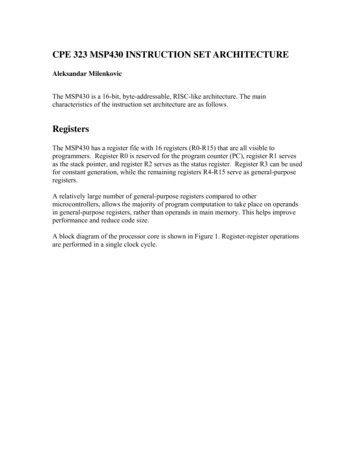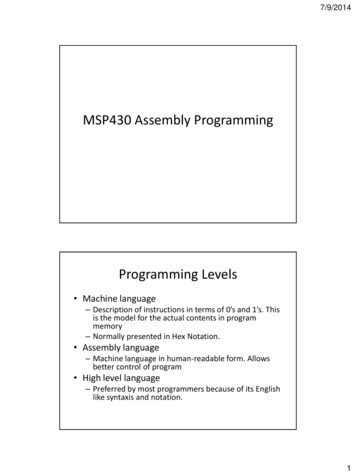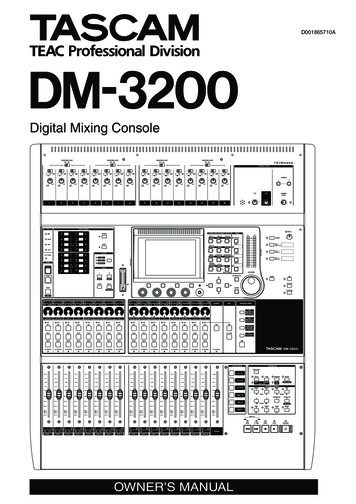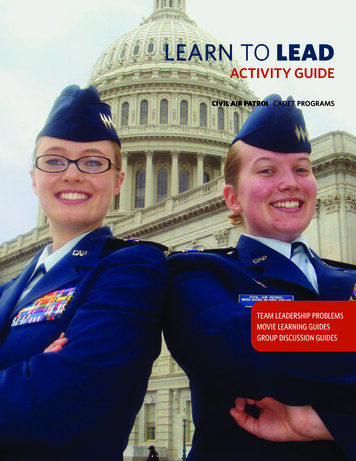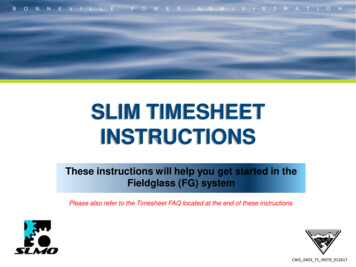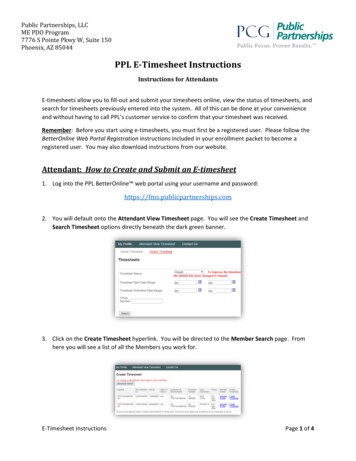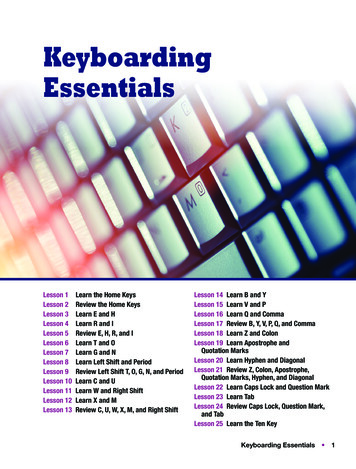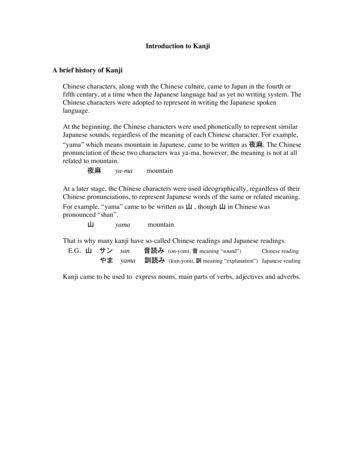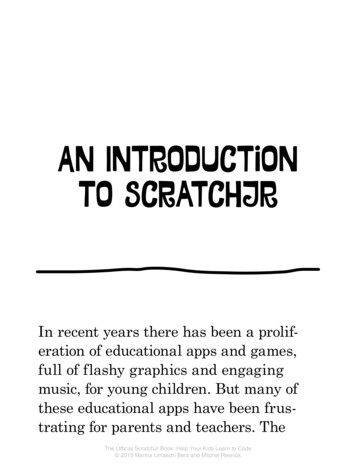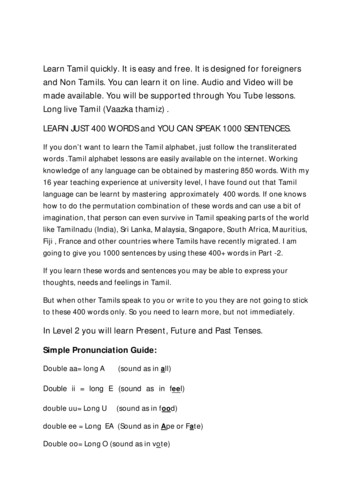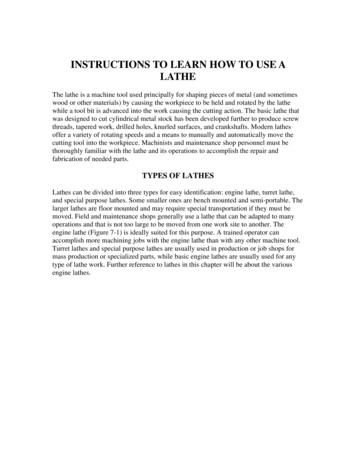
Transcription
INSTRUCTIONS TO LEARN HOW TO USE ALATHEThe lathe is a machine tool used principally for shaping pieces of metal (and sometimeswood or other materials) by causing the workpiece to be held and rotated by the lathewhile a tool bit is advanced into the work causing the cutting action. The basic lathe thatwas designed to cut cylindrical metal stock has been developed further to produce screwthreads, tapered work, drilled holes, knurled surfaces, and crankshafts. Modern lathesoffer a variety of rotating speeds and a means to manually and automatically move thecutting tool into the workpiece. Machinists and maintenance shop personnel must bethoroughly familiar with the lathe and its operations to accomplish the repair andfabrication of needed parts.TYPES OF LATHESLathes can be divided into three types for easy identification: engine lathe, turret lathe,and special purpose lathes. Some smaller ones are bench mounted and semi-portable. Thelarger lathes are floor mounted and may require special transportation if they must bemoved. Field and maintenance shops generally use a lathe that can be adapted to manyoperations and that is not too large to be moved from one work site to another. Theengine lathe (Figure 7-1) is ideally suited for this purpose. A trained operator canaccomplish more machining jobs with the engine lathe than with any other machine tool.Turret lathes and special purpose lathes are usually used in production or job shops formass production or specialized parts, while basic engine lathes are usually used for anytype of lathe work. Further reference to lathes in this chapter will be about the variousengine lathes.
ENGINE LATHESSizesThe size of an engine lathe is determined by the largest piece of stock that can bemachined. Before machining a workpiece, the following measurements must beconsidered: the diameter of the work that will swing over the bed and the length betweenlathe centers (Figure 7-1).CategoriesSlight differences in the various engine lathes make it easy to group them into threecategories: lightweight bench engine lathes, precision tool room lathes, and gap lathes,which are also known as extension-type lathes. These lathe categories are shown inFigure 7-2 Different manufacturers may use different lathe categories.
LightweightLightweight bench engine lathes are generally small lathes with a swing of 10 inches orless, mounted to a bench or table top. These lathes can accomplish most machining jobs,but may be limited due to the size of the material that can be turned.PrecisionPrecision tool room lathes are also known as standard manufacturing lathes and are usedfor all lathe operations, such as turning, boring, drilling, reaming, producing screwthreads, taper turning, knurling, and radius forming, and can be adapted for specialmilling operations with the appropriate fixture. This type of lathe can handle workpiecesup to 25 inches in diameter and up to 200 inches long. However, the general size is abouta 15-inch swing with 36 to 48 inches between centers. Many tool room lathes are used forspecial tool and die production due to the high accuracy of the machine.GAP OR EXTENSION-TYPE LATHESGap or extension-type lathes are similar to toolroom lathes except that gap lathes can beadjusted to machine larger diameter and longer workpieces The operator can increase theswing by moving the bed a distance from the headstock, which is usually one or two feet.By sliding the bed away from the headstock, the gap lathe can be used to turn very longworkpieces between centers.
LATHE COMPONENTSEngine lathes all have the same general functional parts, even though the specific locationor shape of a certain part may differ from one manufacturer The bed is the foundation ofthe working parts of the lathe to another (Figure 7-3).The main feature of its construction are the ways which are formed on its upper surfaceand run the full length of the bed.Ways provide the means for holding the tailstock and carriage, which slide along theways, in alignment with the permanently attached headstockThe headstock is located on the operator's left end of the lathe bed. It contains the mainspindle and oil reservoir and the gearing mechanism for obtaining various spindle speedsand for transmitting power to the feeding and threading mechanism. The headstockmechanism is driven by an electric motor connected either to a belt or pulley system or toa geared system. The main spindle is mounted on bearings in the headstock and ishardened and specially ground to fit different lathe holding devices. The spindle has ahole through its entire length to accommodate long workpieces. The hole in the nose ofthe spindle usually has a standard Morse taper which varies with the size of the lathe.Centers, collets, drill chucks, tapered shank drills and reamers may be inserted into thespindle. Chucks, drive plates, and faceplates may be screwed onto the spindle or clampedonto the spindle nose.The tailstock is located on the opposite end of the lathe from the headstock. It supportsone end of the work when machining between centers, supports long pieces held in the
chuck, and holds various forms of cutting tools, such as drills, reamers, and taps. Thetailstock is mounted on the ways and is designed to be clamped at any point along theways. It has a sliding spindle that is operated by a hand wheel and clamped in position bymeans of a spindle clamp. The tailstock may be adjusted laterally (toward or away fromthe operator) by adjusting screws. It should be unclamped from the ways before anylateral adjustments are made, as this will allow the tailstock to be moved freely andprevent damage to the lateral adjustment screws.The carriage includes the apron, saddle, compound rest, cross slide, tool post, and thecutting tool. It sits across the lathe ways and in front of the lathe bed. The function of thecarriage is to carry and move the cutting tool. It can be moved by hand or by power andcan be clamped into position with a locking nut. The saddle carries the cross slide and thecompound rest. The cross slide is mounted on the dovetail ways on the top of the saddleand is moved back and forth at 90 to the axis of the lathe by the cross slide lead screw.The lead screw can be hand or power activated. A feed reversing lever, located on thecarriage or headstock, can be used to cause the carriage and the cross slide to reverse thedirection of travel. The compound rest is mounted on the cross slide and can be swiveledand clamped at any angle in a horizontal plane. The compound rest is used extensively incutting steep tapers and angles for lathe centers. The cutting tool and tool holder aresecured in the tool post which is mounted directly to the compound rest. The aproncontains the gears and feed clutches which transmit motion from the feed rod or leadscrew to the carriage and cross slide.CARE AND MAINTENANCE OF LATHESLathes are highly accurate machine tools designed to operate around the clock if properlyoperated and maintained. Lathes must be lubricated and checked for adjustment beforeoperation. Improper lubrication or loose nuts and bolts can cause excessive wear anddangerous operating conditions.The lathe ways are precision ground surfaces and must not be used as tables for othertools and should be kept clean of grit and dirt. The lead screw and gears should bechecked frequently for any metal chips that could be lodged in the gearing mechanisms.Check each lathe prior to operation for any missing parts or broken shear pins. Refer tothe operator's instructions before attempting to lift any lathe. Newly installed lathes orlathes that are transported in mobile vehicles should be properly leveled before anyoperation to prevent vibration and wobble. Any lathes that are transported out of a normalshop environment should be protected from dust, excessive heat, and very coldconditions. Change the lubricant frequently if working in dusty conditions. In hotworking areas, use care to avoid overheating the motor or damaging any seals. Operatethe lathe at slower speeds than normal when working in cold environments.SAFETYAll lathe operators must be constantly aware of the safety hazards that are associated withusing the lathe and must know all safety precautions to avoid accidents and injuries.
Carelessness and ignorance are two great menaces to personal safety. Other hazards canbe mechanically related to working with the lathe, such as proper machine maintenanceand setup. Some important safety precautions to follow when using lathes are: Correct dress is important, remove rings and watches, roll sleeves above elbows.Always stop the lathe before making adjustments.Do not change spindle speeds until the lathe comes to a complete stop.Handle sharp cutters, centers, and drills with care.Remove chuck keys and wrenches before operatingAlways wear protective eye protection.Handle heavy chucks with care and protect the lathe ways with a block of woodwhen installing a chuck.Know where the emergency stop is before operating the lathe.Use pliers or a brush to remove chips and swarf, never your hands.Never lean on the lathe.Never lay tools directly on the lathe ways. If a separate table is not available, usea wide board with a cleat on each side to lay on the ways.Keep tools overhang as short as possible.Never attempt to measure work while it is turning.Never file lathe work unless the file has a handle.File left-handed if possible.Protect the lathe ways when grinding or filing.Use two hands when sanding the workpiece. Do not wrap sand paper or emorycloth around the workpiece.TOOLS AND EQUIPMENTGENERAL PURPOSE CUTTING TOOLSThe lathe cutting tool or tool bit must be made of the correct material and ground to thecorrect angles to machine a workpiece efficiently. The most common tool bit is thegeneral all-purpose bit made of high-speed steel. These tool bits are generallyinexpensive, easy to grind on a bench or pedestal grinder, take lots of abuse and wear,and are strong enough for all-around repair and fabrication. High-speed steel tool bits canhandle the high heat that is generated during cutting and are not changed after cooling.These tool bits are used for turning, facing, boring and other lathe operations. Tool bitsmade from special materials such as carbides, ceramics, diamonds, cast alloys are able tomachine workpieces at very high speeds but are brittle and expensive for normal lathework. High-speed steel tool bits are available in many shapes and sizes to accommodateany lathe operation.SINGLE POINT TOOL BITSSingle point tool bits can be one end of a high-speed steel tool bit or one edge of acarbide or ceramic cutting tool or insert. Basically, a single point cutter bit is a tool thathas only one cutting action proceeding at a time. A machinist or machine operator should
know the various terms applied to the single point tool bit to properly identify and grinddifferent tool bits (Figure 7-4). The shank is the main body of the tool bit.The nose is the part of the tool bit which is shaped to a point and forms the cornerbetween the side cutting edge and the end cutting edge. The nose radius is therounded end of the tool bit.The face is the top surface of the tool bit upon which the chips slide as theyseparate from the work piece.The side or flank of the tool bit is the surface just below and adjacent to thecutting edge.The cutting edge is the part of the tool bit that actually cuts into the workpiece,located behind the nose and adjacent to the side and face.The base is the bottom surface of the tool bit, which usually is ground flat duringtool bit manufacturing.The end of the tool bit is the near-vertical surface which, with the side of the bit,forms the profile of the bit. The end is the trailing surface of the tool bit whencutting.The heel is the portion of the tool bit base immediately below and supporting theface.Angles of Tool BitsThe successful operation of the lathe and the quality of work that may be achieveddepend largely on the angles that form the cutting edge of the tool bit (Figure 7-4). Mosttools are hand ground to the desired shape on a bench or pedestal grinder. The cuttingtool geometry for the rake and relief angles must be properly ground, but the overallshape of the tool bit is determined by the preference of the machinist or machineoperator. Lathe tool bit shapes can be pointed, rounded, squared off, or irregular in shape
and still cut quite well as long as the tool bit angles are properly ground for the type ofmaterial being machined. The angles are the side and back rake angles, the side and endcutting edge angles, and the side and end relief angles. Other angles to be considered arethe radius on the end of the tool bit and the angle of the tool holder. After knowing howthe angles affect the cutting action, some recommended cutting tool shapes can beconsidered.Rake angle pertains to the top surface of the tool bit. There are two types of rake angles,the side and back rake angles (Figure 7-4). The rake angle can be positive, negative, orhave no rake angle at all. The tool holder can have an angle, known as the tool holderangle, which averages about 15 , depending on the model of tool holder selected. Thetool holder angle combines with the back rake angle to provide clearance for the heel ofthe tool bit from the workpiece and to facilitate chip removal. The side rake angle ismeasured back from the cutting edge and can be a positive rake angle or have no rake atall.Rake angles cannot be too great or the cutting edge will lose strength to support thecutting action. The side rake angle determines the type and size of chip produced duringthe cutting action and the direction that the chip travels when leaving the cutting tool.Chip breakers can be included in the side rake angle to ensure that the chips break up anddo not become a safety hazard.Side and relief angles, or clearance angles, are the angles formed behind and beneath thecutting edge that provide clearance or relief to the cutting action of the tool. There aretwo types of relief angles, side relief and end relief. Side relief is the angle ground intothe tool bit, under the side of the cutting edge, to provide clearance in the direction of toolbit travel. End relief is the angle ground into the tool bit to provide front clearance tokeep the tool bit heel from rubbing. The end relief angle is supplemented by the toolholder angle and makes up the effective relief angle for the end of the tool bit.Side and cutting edge angles are the angles formed by the cutting edge with the end of thetool bit (the end cutting edge angle), or with the side of the tool bit (the side cutting edgeangle). The end cutting edge angle permits the nose of the tool bit to make contact withthe work and aids in feeding the tool bit into the work. The side cutting edge anglereduces the pressure on the tool bit as it begins to cut. The side rake angle and the siderelief angle combine to form the wedge angle (or lip angle) of the tool bit that providesfor the cutting action (Figure 7-4).A radius ground onto the nose of the tool bit can help strengthen the tool bit and providefor a smooth cutting action.Shapes of Tool BitsThe overall shape of the lathe tool bits can be rounded, squared, or another shape as longas the proper angles are included. Tool bits are identified by the function they perform,such as turning or facing. They can also be identified as roughing tools or finishing tools.
Generally, a roughing tool has a radius ground onto the nose of the tool bit that is smallerthan the radius for a finishing or general-purpose tool bit. Experienced machinists havefound the following shapes to be useful for different lathe operations.A right-hand turning tool bit is shaped to be fed from right to left. The cutting edge is onthe left side of the tool bit and the face slopes down away from the cutting edge. The leftside and end of the tool bit are ground with sufficient clearance to permit the cutting edgeto bear upon the workpiece without the heel rubbing on the work. The right-hand turningtool bit is ideal for taking light roughing cuts as well as general all-around machining.A left-hand turning tool bit is the opposite of the right-hand turning tool bit, designed tocut when fed from left to right. This tool bit is used mainly for machining close in to aright shoulder.The round-nose turning tool bit is very versatile and can be used to turn in either directionfor roughing and finishing cuts. No side rake angle is ground into the top face when usedto cut in either direction, but a small back rake angle may be needed for chip removal.The nose radius is usually ground in the shape of a half-circle with a diameter of about1/32 inch.The right-hand facing tool bit is intended for facing on right-hand side shoulders and theright end of a workpiece. The cutting edge is on the left-hand side of the bit, and the noseis ground very sharp for machining into a square corner. The direction of feed for thistool bit should be away from the center axis of the work, not going into the center axis.A left-hand facing tool bit is the opposite of the right-hand facing tool bit and is intend tomachine and face the left sides of shoulders.
The parting tool bit, Figure 7-6, is also known as the cutoff tool bit. This tool bit has theprincipal cutting edge at the squared end of the bit that is advanced at a right angle intothe workpiece. Both sides should have sufficient clearance to prevent binding and shouldbe ground slightly narrower at the back than at the cutting edge. Besides being used forparting operations, this tool bit can be used to machine square corners and grooves.
Thread-cutting tool bits, Figure 7-7, are ground to cut the type and style of threadsdesired. Side and front clearances must be ground, plus the special point shape for thetype of thread desired. Thread-cutting tool bits can be ground for standard 60 threadforms or for square, Acme, or special threads. Thread-cutting forms are discussed ingreater detail later in this chapter.
SPECIAL TYPES OF LATHE CUTTING TOOLSBesides the common shaped tool bits, special lathe operations and heavy production workrequire special types of cutting tools. Some of the more common of these tools are listedbelow.Tungsten carbide, tantalum carbide, titanium carbide, ceramic, oxide, and diamondtipped tool bits (Figure 7-8). and cutting tool inserts are commonly used in high-speedproduction work when heavy cuts are necessary and where exceptionally hard and toughmaterials are encountered. Standard shapes for tipped tool bits are similar to high-speedsteel-cutting tool shapes. Carbide and ceramic inserts can be square, triangular, round, orother shapes. The inserts are designed to be indexed or rotated as each cutting edge getsdull and then discarded. Cutting tool inserts are not intended for reuse after sharpening.Specially formed thread cutter mounted in a thread cutter holder (Figure 7-9). This tool isdesigned for production high-speed thread cutting operations. The special design of thecutter allows for sharp and strong cutting edges which need only to be resharpenedoccasionally by grinding the face. The cutter mounts into a special tool holder thatmounts to the lathe tool post.
The common knurling tool, Figure 7-10, consists of two cylindrical cutters, called knurls,which rotate in a specially designed tool holder. The knurls contain teeth which are rolledagainst the surface of the workpiece to form depressed patterns on the workpiece. Thecommon knurling tool accepts different pairs of knurls, each having a different pattern orpitch. The diamond pattern is most widely used and comes in three pitches: 14, 21, or 33.These pitches produce coarse, medium, and fine knurled patterns.Boring tool bits, Figure 7-11, are ground similar to left-hand turning tool bits and threadcutting tool bits, but with more end clearance angle to prevent the heel of the tool bitfrom rubbing against the surface of the bored hole. The boring tool bit is usually clampedto a boring tool holder, but it can be a one-piece unit . The boring tool bit and tool holderclamp into the lathe tool post.
There is no set procedure to grinding lathe tool bit angles and shapes, but there aregeneral guidelines that should be followed. Do not attempt to use the bench or pedestalgrinder without becoming fully educated as to its safety, operation, and capabilities. Inorder to effectively grind a tool bit, the grinding wheel must have a true and clean faceand be of the appropriate material for the cutting tool to be ground. Carbide tool bits mustbe ground on a silicon carbide grinding wheel to remove the very hard metal.High-speed steel tool bits are the only tool bits that can effectively be ground on thebench or pedestal grinder when equipped with the aluminum oxide grinding wheel whichis standard for most field and maintenance shops. Before grinding, shaping, or sharpeninga high-speed steel tool bit, inspect the entire grinder for a safe setup and adjust the toolrests and guards as needed for tool bit grinding (Figure 7-12).
Set the tool rest 1/8 inch or less from the wheel, and adjust the spark arrestor 1/4 inch orless. Each grinder is usually equipped with a coarse-grained wheel for rough grinding anda fine-grained wheel for fine and finish grinding. Dress the face of the grinding wheels asneeded to keep a smooth, flat grinding surface for the tool bit. When grinding the sideand back rake angles, ensure the grinding wheel has a sharp corner for shaping the angle.Dip the tool bit in water occasionally while grinding to keep the tool bit cool enough tohandle and to avoid changing the property of the metal by overheating. Frequentlyinspect the tool bit angles with a protractor or special grinding gage. Grind the tool bit tothe recommended angles in the reference for tool bit geometry (Table 7-l in Appendix A).After grinding to the finished shape, the tool bit should be honed lightly on an oilstone toremove any burrs or irregular high spots. The smoother the finish on the cutting tool, thesmoother the finish on the work. Figure 7-13 shows the steps involved in grinding around nose tool bit to be used for turning in either direction. As a safety note, never usethe side of the grinding wheel to grind a tool bit, as this could weaken the bonding of thewheel and cause it to crack and explode.
TOOL HOLDERS AND TOOL POSTSLathe tool holders are designed to securely and rigidly hold the tool bit at a fixed anglefor properly machining a workpiece (Figure 7-14). Tool holders are designed to work inconjunction with various lathe tool posts, onto which the tool holders are mounted. Toolholders for high speed steel tool bits come in various types for different uses. These toolholders are designed to be used with the standard round tool post that usually is suppliedwith each engine lathe (Figure 7-15 ). This tool post consists of the post, screw, washer,collar, and rocker, and fits into the T-slot of the compound rest.
Standard tool holders for high-speed steel cutting tools have a square slot made to fit astandard size tool bit shank. Tool bit shanks can be 1/4-inch, 5/16-inch, 3/8-inch, and
greater, with all the various sizes being manufactured for all the different lathemanufacturer's tool holder models. Some standard tool holders for steel tool bits are thestraight tool holder, right and left offset tool holder, and the zero rake tool holderdesigned for special carbide tool bits. Other tool holders to fit the standard round toolpost include straight, left, and right parting tool holders, knurling tool holders, boring bartool holders, and specially formed thread cutting tool holders.The turret tool post (Figure 7-16 ) is a swiveling block that can hold many different toolbits or tool holders. Each cutting tool can quickly be swiveled into cutting position andclamped into place using a quick clamping handle. The turret tool post is used mainly forhigh-speed production operations.The heavy-duty or open-sided tool post (Figure 7-17) is used for holding a single carbidetipped tool bit or tool holder. It is used mainly for very heavy cuts that require a rigid toolholder.
The quick-change tool system (Figure 7-18) consists of a quick-change dovetail tool postwith a complete set of matching dovetailed tool holders that can be quickly changed asdifferent lathe operations become necessary. This system has a quick-release knob on thetop of the tool post that allows tool changes in less than 5 seconds, which makes thissystem valuable for production machine shops.
WORK HOLDING DEVICESMany different devices, such as chucks, collets, faceplates, drive plates, mandrels, andlathe centers, are used to hold and drive the work while it is being machined on a lathe.The size and type of work to be machined and the particular operation that needs to bedone will determine which work holding device is best for any particular job. Anotherconsideration is how much accuracy is needed for a job, since some work holding devicesare more accurate than others. Operational details for some of the more common workholding devices follow.The universal scroll chuck, Figure 7-19, usually has three jaws which move in unison asan adjusting pinion is rotated. The advantage of the universal scroll chuck is its ease ofoperation in centering work for concentric turning. This chuck is not as accurate as theindependent chuck, but when in good condition it will center work within 0.002 to 0.003inches of runout.
The jaws are moved simultaneously within the chuck by a scroll or spiral-threaded plate.The jaws are threaded to the scroll and move an equal distance inward or outward as thescroll is rotated by the adjusting pinion. Since the jaws are individually aligned on thescroll, the jaws cannot usually be reversed. Some manufactures supply two sets of jaws,
one for internal work and one for external work. Other manufactures make the jaws intwo pieces so the outside, or gripping surface may be reversed. which can beinterchanged.The universal scroll chuck can be used to hold and automatically center round orhexagonal workpieces. Having only three jaws, the chuck cannot be used effectively tohold square, octagonal, or irregular shapes.The independent chuck, Figure 7-19, generally has four jaws which are adjustedindividually on the chuck face by means of adjusting screws. The chuck face is scribedwith concentric circles which are used for rough alignment of the jaws when chuckinground workpieces. The final adjustment is made by turning the workpiece slowly by handand using a dial indicator to determine it's concentricity. The jaws are then readjusted asnecessary to align the workpiece within the desired tolerances.The jaws of the independent chuck may be used as illustrated or may be reversed so thatthe steps face in the opposite direction; thus workpieces can be gripped either externallyor internally. The independent chuck can be used to hold square, round, octagonal, orirregularly shaped workpieces in either a concentric or eccentric position due to theindependent operation of each jaw.Because of its versatility and capacity for fine adjustment, the independent chuck iscommonly used for mounting odd-shaped workpieces which must be held with extremeaccuracy.A combination chuck combines the features of the independent chuck and the universalscroll chuck and can have either three or four jaws. The jaws can be moved in unison ona scroll for automatic centering or can be moved individually if desired by separateadjusting screws.The drill chuck, Figure 7-19, is a small universal chuck which can be used in either theheadstock spindle or the tailstock for holding straight-shank drills, reamers, taps, or smalldiameter workpieces. The drill chuck has three or four hardened steel jaws which aremoved together or apart by adjusting a tapered sleeve within which they are contained.The drill chuck is capable of centering tools and small-diameter workpieces to within0.002 or 0.003 inch when firmly tightened.The collet chuck is the most accurate means of holding small workpieces in the lathe. Thecollet chuck consists of a spring machine collet (Figure 7-20) and a collet attachmentwhich secures and regulates the collet on the headstock spindle of the lathe.
The spring machine collet is a thin metal bushing with an accurately machined bore and atapered exterior. The collet has three lengthwise slots to permit its sides being sprungslightly inward to grip the workpiece. To grip the workpiece accurately, the collet mustbe no more than 0.005 inch larger or smaller than the diameter of the piece to be chucked.For this reason, spring machine collets are available in increments of 1/64 inch. Forgeneral purposes, the spring machine collets are limited in capacity to 1 1/8 inch indiameter.For general purposes, the spring machine collets are limited in capacity to 1 1/8 inch indiameter.The collet attachment consists of a collet sleeve, a drawbar, and a handwheel or handlever to move the drawbar. The spring machine collet and collet attachment together formthe collet chuck. Figure 7-20 illustrates a typical collet chuck installation. The colletsleeve is fitted to the right end of the headstock spindle. The drawbar passes through theheadstock spindle and is threaded to the spring machine collet. When the drawbar is
rotated by means of the hand wheel, it draws the collet into the tapered adapter, causingthe collet to tighten on the workpiece. Spring machine collets are available in differentshapes to chuck square and hexagonal workpieces of small dimensions as well as roundworkpieces.The Jacob's spindle-nose collet chuck (Figure 7-21) is a special chuck is used for theJacob's rubber flex collets. This chuck combines the functions of the standard colletchuck and drawbar into one single compact unit. The chuck housing has a handwheel o
INSTRUCTIONS TO LEARN HOW TO USE A LATHE The lathe is a machine tool used principally for shaping pieces of metal (and sometimes wood or other materials) by
